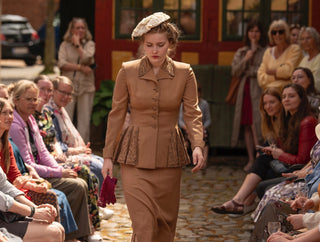The second world war had an influence on the fashion era in 1940’s. Read about and get inspiration on how women and men dressed during the 1940’s fashion.
Functional Elegance and Resilient Style
Fashion in the 1940s was deeply influenced by World War II (1939-1945), when resources and materials were scarce, and many countries introduced textile rationing. This forced the clothing industry and fashion houses to adapt, resulting in a more functional and austere style. At the same time, there was a strong resistance to the hardships of war, expressed through a desire for elegance when circumstances allowed.

Practical 1940s inspired look with pants, and my Rosemary cardigan with fair isle print. The boots are my Robbie boots, inspired by an original military boot from the 1940s.
'Make Do and Mend'
During the war, fashion focused on practical and functional clothing. Women often had to take on men’s roles in the workforce, which led to trousers becoming more widely accepted as everyday wear. Jumpsuits and overalls became popular workwear for women, especially for those working in factories or agriculture. Clothing was often made from durable materials like wool, cotton, and rayon, as luxurious fabrics like silk were used for war production (e.g., parachutes).
1940s working class women's fashion
Clothing rationing forced women to be creative with their wardrobes. The "Make Do and Mend" trend emerged, where old clothes were adapted or new garments were sewn from recycled materials. Clothing was often made from hard-wearing fabrics like cotton or rayon. Parachutes left by the soldiers on fields could be used as fabric for a wedding dress or underwear. Skirts became shorter to save fabric, often reaching the knee or just below. Long coats, simple blouses, and A-line skirts became the standard. People became very creative with hats, bags, and other accessories, using scraps of ribbon, fabric, buttons, and even telephone cords to give a personal touch. Because fo this, you often see creative, strange and at times obscure hats from the 1940s.
 Fair isle knits, like my Rosemary cardigan was a great way to use left over yarn to create both beautiful and practical pieces of clothing.
Fair isle knits, like my Rosemary cardigan was a great way to use left over yarn to create both beautiful and practical pieces of clothing.
Military uniforms had a major influence on fashion, especially with sharp shoulders and tailored silhouettes. Shoulder pads were popular, giving a distinctive silhouette with broad shoulders and a narrow waist.
Although functionality was the main focus, there was still an emphasis on maintaining an elegant look. Women used hair and make up as an expression of optimism and resilience. Evening gowns and glamorous clothing were still worn for special occasions, and decorated with small details like pearls or brooches to add elegance.
1940s upper class womens fashion
Upper-class fashion in the 1940s was also influenced by the demands of World War II. While wartime rationing limited the availability of luxury fabrics, the wealthy still managed to express their status through elegant, refined styles.
The 1940s saw a shift to more tailored, structured silhouettes. The wartime "utility" dress, often made from rationed fabrics like wool or rayon, featured simple lines with functional details, such as pockets and modest necklines. When it came to evening wear, the upper class embraced glamorous, yet practical designs, such as A-line skirts and tailored jackets. Fabrics like silk, velvet, and taffeta were used for formal events, though silk were heavily rationed. Accessories like fur stoles, pearls, and elaborate hats were popular, and women’s hair was styled into soft curls or beautiful updos, reflecting a glamorous look.
New Look: A Post-War Fashion Revolution
Fashion changed significantly after the war ended in 1945. The most iconic change came with Christian Dior’s "New Look" in 1947. This style was a reaction against the austere wartime fashions and featured lavish, voluminous skirts that reached mid-calf, narrow waists, and soft, rounded shoulders. At a time when large parts of Europe were still in the process of rebuilding cities and economies after the devastation of the war, it seemed provocative to use so much fabric on extravagant skirts and luxurious designs. On the other hand, for many, the "New Look" symbolized a longing for normality, beauty, and luxury after years of hardship and crisis.

A New Look inspired walking suit. Note the fitted waist, wider hips and feminine details, paired with my 1940s inspired pumps, Esther.
1940s women's shoes
Like clothing, 1940s shoes were rationed, meaning they had to be practical and durable. Leather was in short supply, so shoemakers had to find alternative materials like cork or wood for soles, and spotted hide was used as a substitute for leather. The practical Oxford shoe remained a favorite for both men and women, and pumps became popular for women. After the war, more glamorous shoes with high-heeled designs returned, especially in evening sandals decorated with cut-outs and peep-toe.

Emily is my classic 1940s inspired Oxfords with a sturdy heel. Note the cut outs and rounded toe.
Mens 1940s Fashion
1940s mens fashion was similarly influenced by the war. Many men were in the military and wore uniforms daily. For civilian men, clothing rationing was also introduced, which meant that clothes were designed with minimal fabric use. Suits became simpler and more streamlined, with fewer details such as cuffs and pocket flaps to save fabric. Trousers were high-waisted and often straight or slightly narrow in cut. Hats, like the fedora, remained an important part of men’s fashion, and more casual items like sweaters and sports jackets also became common in men's wardrobes.
1940s working class men's fashion
Workwear typically consisted of simple trousers or overalls, paired with button-down shirts or work jackets. Fabrics like wool, denim, and durable cotton were commonly used. Footwear was sturdy, such as leather boots or shoes designed to withstand long hours of physical labor. With many men enlisted in the military, military-inspired styles like khaki trousers and field jackets became part of everyday wear, even for civilians. Knitted sweater vests, with fair isle print, which could be made from different scraps of yarn became a popular everyday fashion item for men.

A 1940's working class mens outfit, with the influence of the military uniforms, paired with my 1940's inspired military boots, Robbie.
1940s upper class mens fashion
Suits remained the staple of upper-class fashion, though they became more restrained during the war due to fabric shortages. After the war, men’s suits were typically single-breasted with a more streamlined look, featuring broader shoulders, nipped-in waists, and trousers with a higher waistline. Fabrics were often heavier, such as wool or tweed, and colors were typically muted, with gray, brown, and navy being popular choices. For evening occasions, men wore tuxedos, often with shawl or peak lapels, paired with formal accessories like cufflinks and bow ties.
Men’s Shoes and Boots in the 1940s
When World War II began, many men were drafted or enlisted, and military-issued boots became standard for soldiers. These combat boots were sturdy, lace-up styles made to withstand tough conditions. Their practical design had a lasting impact, even on civilian footwear. After the war, many veterans continued wearing their service boots, and military-inspired styles remained popular throughout the decade.
On the home front, rationing and material shortages meant shoes had to be practical. Leather was hard to come by, so alternatives like rubber soles and synthetic materials were often used. Shoes were built for durability rather than fashion.

Robbie is a unisex boot inspired by 1940s World War II military styles, crafted from full-grain leather with a durable rubber sole. It comes in black or brown and is available in sizes for both men and women.
If you're looking to transport yourself into another fashion era, then you can read our guide on the 1950s fashion scene. Or if you're a big shoe-lover like us, you would perhaps also like to read about the Pompadour Heel.
Sources:
- Shoes - An Illustrated Story by Rebecca Shawcross
- Tidens Mode by Anne-Grete Steckhahn
- Vintage Fashion - Collecting and wearing designer classics by Emma Baxter-Wright, Karen Clarkson, Sarah Kennedy, and Kate Mulvey
- Vintage shoes - Caroline Cox


